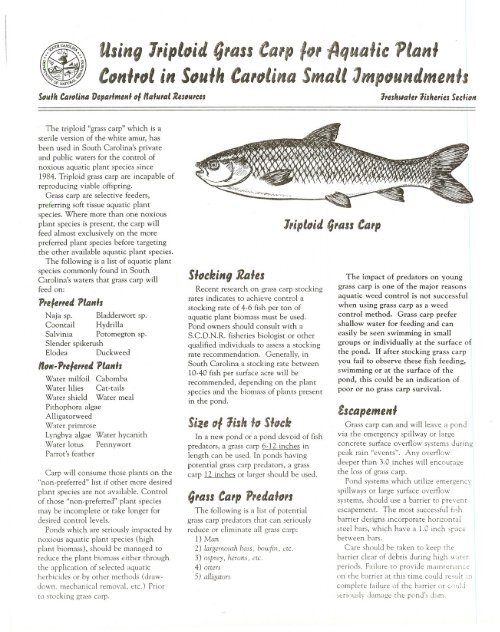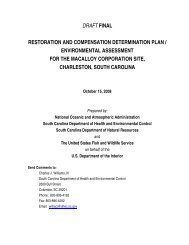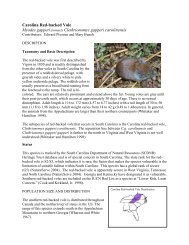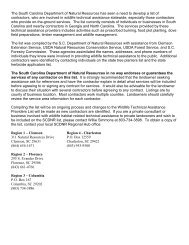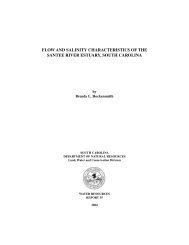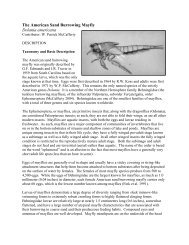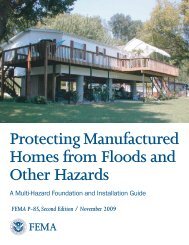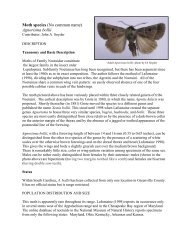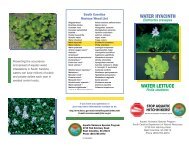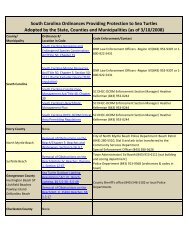Using Triploid Grass Carp for Aquatic Plant Control in SC Small ...
Using Triploid Grass Carp for Aquatic Plant Control in SC Small ...
Using Triploid Grass Carp for Aquatic Plant Control in SC Small ...
You also want an ePaper? Increase the reach of your titles
YUMPU automatically turns print PDFs into web optimized ePapers that Google loves.
<strong>Us<strong>in</strong>g</strong> 1,ipt"id qrass <strong>Carp</strong> fD' Aqual;c Planl<br />
Cllnl,,,t <strong>in</strong> S,"'h Ca,,,l<strong>in</strong>a <strong>Small</strong> JmptlundmenlJ<br />
So"lh Carol<strong>in</strong>a 'Deparlmenl 01 nalural Resources 1reshldaler 1isheries Sedif11f<br />
The triploid "grass carp" which is a<br />
sterile version of the white amur, has<br />
been used <strong>in</strong> South Carol<strong>in</strong>a's private<br />
and public waters <strong>for</strong> the control of<br />
noxious aquatic plant species s<strong>in</strong>ce<br />
19E:4. <strong>Triploid</strong> grass carp are <strong>in</strong>capable of<br />
reproduc<strong>in</strong>g viable offspr<strong>in</strong>g.<br />
CJrass carp are selective feeders,<br />
preferr<strong>in</strong>g soft tissue aquatic plant<br />
species. Where more than one noxious<br />
plant species is present, the carp will<br />
feed almost exclusively on the more<br />
preferred plant species be<strong>for</strong>e target<strong>in</strong>g<br />
the other available aquatic plant species.<br />
The follow<strong>in</strong>g is a list of aquatic plant<br />
species commonly found <strong>in</strong> South<br />
Carol<strong>in</strong>a's waters that grass carp will<br />
feed on:<br />
'Pre'erred 'Ptanh<br />
Naja sp. Bladderwort sp.<br />
Coontail Hydrilla<br />
Salv<strong>in</strong>ia Potomegton sp.<br />
Slender spikerush<br />
Elodea Duckweed<br />
n"lti- 'Pre/erred 'Ptanh<br />
Water milfoil Cabomba<br />
Water lilies Cat-tails<br />
Water shield Water meal<br />
Pil:hophora algae<br />
Alligatorweed<br />
Water primrose<br />
Lyngbya algae Water hycanith<br />
Water lotus Pennywort<br />
Parrot's feather<br />
<strong>Carp</strong> will consume those plants on the<br />
"non-preferred" list if other more desired<br />
plant species are not available. <strong>Control</strong><br />
of those "non-preferred" plant species<br />
may be <strong>in</strong>complete or take longer <strong>for</strong><br />
desired control levels.<br />
Ponds which are seriously impacted by<br />
noxious aquatic plant species (high<br />
plant biomass), should be managed to<br />
reduce the plant biomass either through<br />
the application of selected aquatic<br />
herbicides or by other methods (drawdown,<br />
mechanical removal, ete.) Prior<br />
to stock<strong>in</strong>g grass carp.<br />
SltJck<strong>in</strong>g !lale!<br />
lripltJid qran<br />
Recent research on grass carp stock<strong>in</strong>g<br />
rates <strong>in</strong>dicates to achieve control a<br />
stock<strong>in</strong>g rate of 4-6 fish per ton of<br />
aquatic plant biomass must be used.<br />
Pond owners should consult with a<br />
S.C.D.N.R. fisheries biologist or other<br />
qualified <strong>in</strong>dividuals to assess a stock<strong>in</strong>g<br />
rate recommendation. Generally, <strong>in</strong><br />
South Carol<strong>in</strong>a a stock<strong>in</strong>g rate between<br />
10-40 fish per surface acre will be<br />
recommended, depend<strong>in</strong>g on the plant<br />
species and the biomass of plants present<br />
<strong>in</strong> the pond.<br />
Si~e !11lish 111 SIDcll<br />
In a new pond or a pond devoid of fish<br />
predators, a grass carp 6-12 <strong>in</strong>ches <strong>in</strong><br />
length can be used. In ponds hav<strong>in</strong>g<br />
potential grass carp predators, a grass<br />
carp 12 <strong>in</strong>ches or brger should be used.<br />
qrau <strong>Carp</strong> 1',edaltJ,t<br />
The follow<strong>in</strong>g is a list of potential<br />
grass carp predators that can seriously<br />
reduce or elim<strong>in</strong>ate all grass carp:<br />
1) i\lan<br />
2) largemowh bi1.ls, bowf<strong>in</strong>, etc.<br />
3) osprey, herons, etc.<br />
4) otters<br />
5) alligators<br />
<strong>Carp</strong><br />
The impact of predators on young<br />
grass carp is one of the major reasons<br />
aquatic weed control is not successful<br />
when us<strong>in</strong>g grass carp as a weed<br />
control method. <strong>Grass</strong> carp prefer<br />
shallow water <strong>for</strong> feed<strong>in</strong>g and can<br />
easily be seen swimm<strong>in</strong>g <strong>in</strong> small<br />
groups or <strong>in</strong>dividually at the surface of<br />
the pond. If after stock<strong>in</strong>g grass carp<br />
you fail to observe these fish feed<strong>in</strong>g,<br />
swimm<strong>in</strong>g or at the surface of the<br />
pond, this could be an <strong>in</strong>dication of<br />
poor or no grass carp survival.<br />
£scapemenl<br />
<strong>Grass</strong> carp can and will leave a pond<br />
via the emergency spillway or large<br />
concrete surface overflow systems dur<strong>in</strong>g<br />
peak ra<strong>in</strong> "events". Any overflow<br />
deeper than 3.0 <strong>in</strong>ches will encourage<br />
the loss of grass carp.<br />
Pond systems which utilize emergenC\'<br />
spillways or large surface overtlow<br />
systems, should use a barrier to rre\'enr<br />
escapement. The most successful fish<br />
barrier designs <strong>in</strong>corporate hori:onral<br />
steel bars, which have a 1.0 <strong>in</strong>ch srace<br />
between bars.<br />
Care should be taken to keep the<br />
barrier clear of debris dur<strong>in</strong>g high watu<br />
periods. Failure to provide rna<strong>in</strong>rerlCllKe<br />
on rhe barrier at this time coulJ re>ult ::,<br />
complete failure of the barrier or coule!<br />
:,cr<strong>in</strong>u:;ly Jam;lge the ponJ's ,brn.
<strong>Grass</strong> carp should be stocked <strong>in</strong> the<br />
spr<strong>in</strong>g <strong>for</strong> best results. Early plant growth<br />
<strong>for</strong> South Carol<strong>in</strong>a's aquatic plants<br />
beg<strong>in</strong>s <strong>in</strong> late March - April. Fish should<br />
be stocked at this time to allow them to<br />
aggressively feed on tender, young plant<br />
growth. S<strong>in</strong>ce the fish's metabolism is<br />
<strong>in</strong>creas<strong>in</strong>g with ris<strong>in</strong>g water temperatures,<br />
they grow at an accelerated rate<br />
and quickly reach a size that elim<strong>in</strong>ates<br />
many potential grass carp predator<br />
problems.<br />
Stlluce "I l;Jh<br />
<strong>Triploid</strong> grass carp can only be sold <strong>in</strong><br />
South Carol<strong>in</strong>a by S.C.D.N.R. approved<br />
grass carp vendors. A department<br />
permit is issued by the vendor to each<br />
<strong>in</strong>dividual who obta<strong>in</strong>s these fish<br />
verify<strong>in</strong>g the fish as be<strong>in</strong>g "triploids".<br />
£englh<br />
1)1Weed CDnlrgl<br />
Depend<strong>in</strong>g on the :1quatic weed<br />
species, plant biomass, number of fish<br />
stocked, and grass carp survival, effective<br />
weed control success can vary from<br />
1-10 years <strong>in</strong> most South Carol<strong>in</strong>a<br />
ponds. Effective weed control should be<br />
evident 6-12 months after the <strong>in</strong>itial<br />
stock<strong>in</strong>g<br />
of the carp.<br />
qran carp and<br />
Ban/Bluegill<br />
<strong>Grass</strong> carp are ma<strong>in</strong>ly herbivores but<br />
will consume <strong>in</strong>sects, <strong>in</strong>vertebrates, and<br />
other gamefish food organisms. There is<br />
no documentation that <strong>in</strong>dicates that<br />
grass carp are serious predators<br />
on other<br />
fish species. <strong>Grass</strong> carp do compete with<br />
typical bassjbluegill populations <strong>for</strong><br />
food, there<strong>for</strong>e, some competition<br />
between species does exist.<br />
<strong>Grass</strong> carp will consume float<strong>in</strong>g<br />
pelleted fish feeds and prefer these feeds<br />
over aquatic plants. In ponds where<br />
supplemental feed<strong>in</strong>gs of bream or<br />
channel catfish is desired, you may want<br />
to consider other aquatic weed control<br />
options.<br />
If you have further questions or need<br />
additional assistance on the "use of grass<br />
carp", please call (803)734-3933.<br />
A list of S.C.D.N.R. approved triploid<br />
grass carp vendors can be obta<strong>in</strong>ed by<br />
writ<strong>in</strong>g to:<br />
Hatchery Coord<strong>in</strong>ator<br />
S.C.D.N.R.<br />
Wildlife and Freshwater Fisheries<br />
P.O. Box 167<br />
Columbia, <strong>SC</strong> 29202<br />
The South Carol<strong>in</strong>a Department of Natural Resources prohibits the cli~crim<strong>in</strong>,ltion on the hasis of race, co!nt, 0


